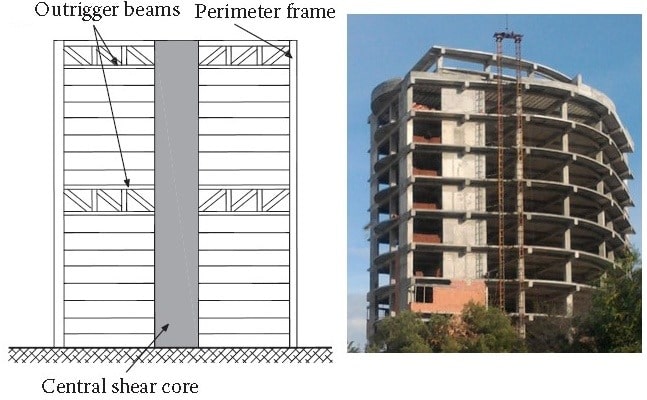Structural Systems for Construction of Multistory Building
There different types of structural systems which are used in the construction of multistory buildings. These systems for multi storey buildings can provide resistance to earthquake forces.
Details of these structural systems are discussed in the following sections.
Structural Systems for Construction of Multistory Buildings
- Moment resisting frames
- Shear wall systems
- Frame-wall or dual systems
- Flat slabs combined with shear walls and frames
- Tube systems
- Mega core systems
1. Moment resisting frames
As it may be noticed from Figure 1, moment resisting frame consist of plane frames configured in two directions perpendicular to each other.
Such system possesses high redundancy, sufficient torsional rigidity, regularities, and structural ability to withstand horizontal forces in any direction and the force may act.

Fig.1: Moment resisting frames
Another feature of this system is that column and beams sections should be enlarged since bending moments, shear forces, and axial forces would get larger at the lower storeys.
Moreover, the system is claimed to be suitable for about 20 storeys and the joints between columns and beams should be detailed properly since it would become a weak point of the structure during earthquake.
Finally, if the above required joint detailing is failed to obtain, then soft storey would occur which is not desirable. Therefore, moment resisting system should not be used if proper design especially at joints cannot be produced.
2. Shear Wall Systems
Due to that fact that the wall takes most of shear base when walls and columns are used in moment resisting buildings, that is why it is named as shear wall system.
Shear wall is another type of structural systems used in the construction of multistory buildings. For the same cross-section, it provides superior stiffness compared with columns. As a result, the lateral deflection of the structure is much smaller in comparison to that occurs in the cause of using columns.
Moreover, it is demonstrated that the ability of shear walls to handle bending moments is better than columns. Shear wall system is suitable for buildings with 20 storeys and it has shown considerably satisfactory behavior during earthquakes. It should however be known that it has lower redundancy compare with framed ones.

Fig.2: Buildings with shear wall systems
3. Frame-Wall or Dual Systems
Dual wall systems are the combination of shear walls with frame systems. Not only does it offer the benefits of both systems together but also eliminate their drawbacks.
Generally, frames are placed around the perimeter of the building and shear walls are placed at the center of the structure around staircases or lifts.
Added to that, it is necessary to place shear wall at the perimeter of the structure when the wall that placed at the middle of the structure does not coincides with the center of mass of the structure.
Moreover, when frames at the center of the structure is connected to the perimeter columns, not only does gravity load carrying capacity of slabs would increase but also the stiffness of the system increases and consequently structural displacement due to earthquakes would decline substantially.
The height of structures in which this system is used can be reach up to 50 storeys.
Finally, such system has two line of defense against earthquake effects the first one is the formation of plastic hinges at the base of the wall and the second one is the moment resisting frames that play its role after plastic hinges has been formed.

Fig.3: Dual wall system in multistory structure
4. Flat Slabs Combined with Shear Walls and Frames
It is composed of two-way flat slabs resting on columns, shear walls at the perimeter or core of the buildings, and moment resisting frame at the perimeter of the structure. Such system is suitable for up to 10 story structures.
It should be known that, the flat slab column joint has low ductility and therefore flat slab strip and column frame is suitable only for gravity loads. So, flat slab-column frame should be used as a secondary structural member.
Finally, this structural system framework is simple and cost effective and provides clear storey height.

Fig.4: Flat slab combined with shear walls and frames
5. Tube Systems
It is a developed version of moment resisting frames which is described as three dimensional rigid frames that able to withstand lateral loads due to earthquakes. Or it is a strong cantilever place perpendicular on the ground.
The structural rigidity of tube system can be improved by decreasing the spacing between perimeter columns, increase spandrel beam depth, and combining more than one tube.
6. Mega core systems
Mega core system consists of reinforced concrete or composite shear walls with much cross sections that conventional shear walls extended continuously throughout the full height of the structure.
Mega core structural system is able to withstand both lateral loads due to earthquakes and wind, and vertical loads and suitable for a structure with 50 storeys.

Fig.5: Shenton way structure in Singapore, mega core structural system used.
No comments:
Post a Comment